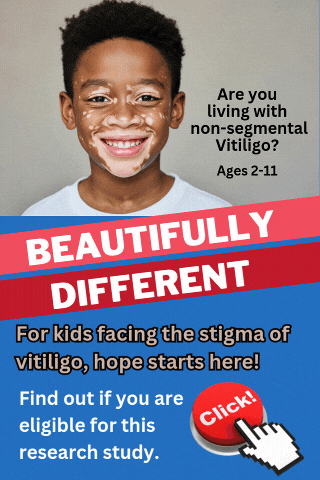Medisearch Clinical Trials
1419 Village Drive
St. Joseph, Mo. 64506
Vitiligo Ages 2-11
Clinical Trial: NCB 18424-312

The clinical trial INCB 18424-312 is a Phase 3, double-blind, randomized, vehicle-controlled study designed to evaluate the safety and efficacy of ruxolitinib cream in pediatric participants aged 2 to 11 years with nonsegmental vitiligo.
CALL NOW TO SEE IF YOU QUALIFY
816-364-1515
Understanding Pediatric Vitiligo: Causes, Effects, and Emotional Impact
What is Pediatric Vitiligo?
Vitiligo is a chronic skin condition that causes loss of pigment in certain areas, leading to white patches on the skin. It occurs when melanocytes, the cells responsible for producing skin pigment (melanin), are destroyed. Pediatric vitiligo refers to vitiligo that develops in children, often before the age of 12. The condition can affect any part of the body, including the face, hands, arms, legs, and even the scalp. While vitiligo is not contagious or life-threatening, it can have significant emotional and psychological effects on children.
What Causes Vitiligo in Children?
The exact cause of vitiligo is not fully understood, but researchers believe it is a combination of genetic, autoimmune, and environmental factors. Some potential causes include:
-
Autoimmune Response: The immune system mistakenly attacks melanocytes, leading to depigmentation.
-
Genetics: A family history of vitiligo or other autoimmune disorders may increase a child’s risk.
-
Environmental Triggers: Certain factors like stress, skin trauma, sunburn, or exposure to certain chemicals may contribute to the onset of vitiligo.
-
Neurogenic Factors: Some theories suggest that nerve cells may release toxic substances that damage melanocytes.
Physical Effects of Vitiligo
Vitiligo presents as milky-white patches on the skin, which may gradually spread over time. The condition itself does not cause pain, itching, or discomfort, but it can make affected skin more sensitive to sunburn. In some cases, vitiligo may also impact hair color, causing white patches in the scalp, eyelashes, or eyebrows.
Emotional and Psychological Effects on Children
Living with vitiligo can be challenging for children, especially as they navigate school and social interactions. The visibility of the condition may lead to:
-
Self-consciousness and Low Self-esteem: Children with vitiligo may feel different from their peers, leading to a decrease in confidence.
-
Social Anxiety and Bullying: Some children may experience teasing or bullying due to the appearance of their skin.
-
Emotional Distress: Feelings of sadness, frustration, or isolation may arise, especially if children struggle to understand why their skin is changing.
-
Parental Concern: Parents often worry about their child's emotional well-being and may seek ways to boost their child’s self-confidence.
Support and Treatment Options
While there is no cure for vitiligo, treatment options can help manage the condition. These include topical creams, light therapy, and innovative treatments such as targeted therapies. Support groups and counseling can also play a crucial role in helping children build self-esteem and navigate social challenges.
It is important to remind children with vitiligo that they are beautiful, unique, and not alone. With the right support and care, they can grow into confident and self-assured individuals, embracing their skin as part of their identity.

It's Rewarding to Refer
Friends & Family!
Medisearch Clinical Trials
1419 Village Drive
St. Joseph, Mo. 64506
GET IN TOUCH
We'd love to hear from you
816-364-1515


